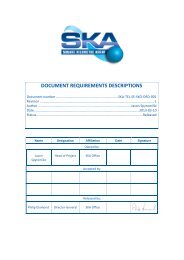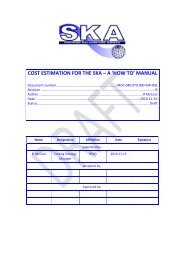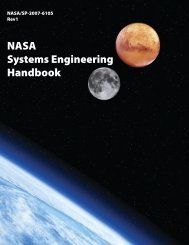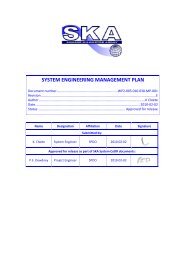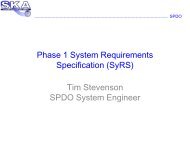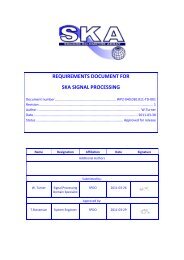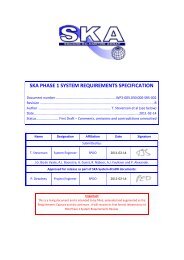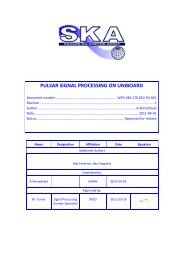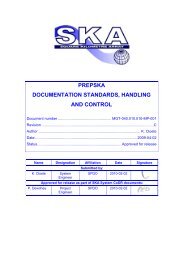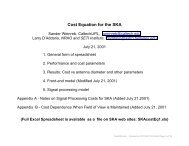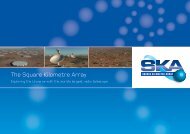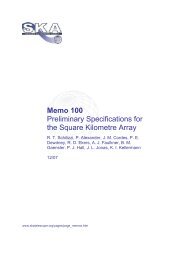Memo 65 SKA Signal processing costs - The Square Kilometre Array
Memo 65 SKA Signal processing costs - The Square Kilometre Array
Memo 65 SKA Signal processing costs - The Square Kilometre Array
You also want an ePaper? Increase the reach of your titles
YUMPU automatically turns print PDFs into web optimized ePapers that Google loves.
<strong>Memo</strong> <strong>65</strong><strong>SKA</strong> <strong>Signal</strong> <strong>processing</strong> <strong>costs</strong>John Bunton, CSIRO ICT Centre12/08/05www.skatelescope.org/pages/page_memos.htm
Introduction<strong>The</strong> delay in the building of the <strong>SKA</strong> has a significant impact on the signal <strong>processing</strong>cost of the <strong>SKA</strong> as it allows more time for Moore’s law to reduce cost. In this paperthe maximum <strong>SKA</strong> survey specifications are derived and it is found that only a fewconcepts are excluded on the basis of signal <strong>processing</strong> cost. It also proposes the useof regular rectangular arrays for antenna stations. This further reduces cost. Forbeamforming, a row-column approach to beamforming can be used. This reducesbeamforming cost by about the square root of the number of antennas in the antennastation. For correlation the regular array forces all the sidelobe energy into gratinglobes. By imaging the grating lobes correlator <strong>costs</strong> can be reduced by up to a factorof ten.With row-column beamforming and imaging of grating lobe the maximum cost ofsignal <strong>processing</strong> is tens of millions of dollars. <strong>The</strong> implication for the <strong>SKA</strong> is thatthe sensitivity is almost totally dependent on the cost of the reflector and feedstructure. For reflector based design this implies a reflector diameter or width ofabout 5m to minimise cost and ensure operation down to 300 MHz.<strong>SKA</strong> specificationFrom the <strong>SKA</strong> web site the current <strong>SKA</strong> specifications that are relevant to the cost ofsignal <strong>processing</strong> in a wide field of view design are:Instantaneousbandwidth ofeach observingbandSimultaneousindependentobservingbandsContiguousimaging fieldof view (FoV)Sensitivity at45 degreeselevation(A/T)Survey speedFull width = 25% of observing band center frequency, up to amaximum of4 GHz BW for all frequencies above 16 GHz2 pairs (2 polarizations at each of two independentfrequencies, with same FoV centers)1 square degree within half power points at 1.4 GHz, scalingas λ 2 , 200 sq. deg. within half power points at 0.7 GHz,scaling as λ 2 between 0.5-1.0 GHzGoal: 2500 at 60 MHz5000 at 200 MHz, 20000 between 0.5 and 5 GHz, 15000 at 15GHz,and 10000 at 25 GHz Goal: 5000 at 35 GHzFoV x (A/T) 2 x BW = 3 x 10 17 deg 2 m 4 K -2 Hz at 1.5 GHzFoV x (A/T)2 x BW = 1.5 x 10 19 deg 2 m 4 K -2 Hz at 0.7 GHzWith two simultaneous observing bands of 25% bandwidth the bands could be chosenat 622MHz with a bandwidth of 156MHz and 800 MHz with a bandwidth of 200MHz. Thus the two simultaneous bands would cover a total bandwidth of 356 MHz.<strong>The</strong> Sensitivity specification at 200 MHz is equivalent to a total effective aperture ofone square kilometre assuming Tsky of 170K and 30K contribution from the receiver,1©CSIRO 2005
Filterbanks<strong>The</strong> model proposed for beamforming at an antenna is first pass the data through afilterbank and then use simple weight and sum beamforming [Horiuchi et al 2004,Hall 2002, Bunton 2005]. If there is no antenna beamforming then the filterbank isstill needed for the FX correlator. Thus every signal that comes from an antenna mustbe processed by a filterbank and the total number of signals that come from theantennas is equal to the total number of beams generated multiplied by a conceptdependent constant, R fb [Bunton 2005]. <strong>The</strong> constant R fb is the ratio of the number ofinputs to an antenna beamformer divided by the number of independent output beamsand varies from 1 for a dish with a single feed to 4 for an aperture array with RFbeamforming. In some concepts the R fb is frequency dependent. For example for anfocal plane array on a parabolic dish it is estimated to be 2.4 at the maximumoperating frequency and increases to 9.6 at half this frequency. This occurs becausethe number of beams is approximately proportional to the square of the frequency.For the moment discussion will be restricted to operation of a feed array at itsmaximum frequency.<strong>The</strong> minimum value of R fb is 1. Using this value will give a minimum cost forfilterbanks. For each real data sample into the filterbank approximately 20 realmultiplies are needed. <strong>The</strong> total data rate into the filter banks is 474,000 beams times356 MHz times 2 samples/s/Hz. This give an input data rate of 337 Tsamples/s and atotal multiply rate of 6750 Tmultiplies/s. <strong>The</strong> current cost of multipliers, using aVirtex4 LS35 as a reference, is about US$4000 per Tmultiplies/s. If the <strong>SKA</strong> is to bebuilt in 10 years time and if Moore’s law were to operate until the building of the<strong>SKA</strong> then the cost of multipliers would be reduced by a factor of 90. Even using amore conservative reduction by a factor of 32 brings the cost down to US$125Tmultiplies/s. As a rough estimate, total system cost is double the FPGA costbringing the system cost to US$250 Tmultiplies/s and the total cost of filterbanks isUS$1.7 million. For concepts where R fb is greater than 1 this becomes US$1.7million x R fb .Correlator<strong>The</strong> cost of filterbanks and signal transport are low and vary little from concept toconcept, but this is not true for the correlator. As a first step the maximum cost of thecorrelator is estimated. This occurs when each beam has the maximum field of viewor 200 square degrees and there are 474,000 signals into the correlator which must becorrelated together. An example of such a design is 474,000 2-m dishes. If the central75% of these dishes are used for wide field imaging then there are 250 billioncorrelations (full Stokes parameters). Each correlation is a complex multiply of 4+4-bit data and in an FPGA implementation this is one quarter the cost of a multiply inthe filterbanks and there are four multiplies per correlation. This gives a correlationcost of US$250/THz. Each correlation has a bandwidth of 356 MHz and <strong>costs</strong>US$0.089 each giving a total cost of US$22.5 billion. For larger diameter dishes thecost per beam scales as the inverse of area squared and the number of beams isproportional to the area. So for a 6m dish the correlator cost is US$2.5 billion, for a15m dish it is US$400 million, and for a small cylindrical reflector with an area of600m 2 the cost is US$118 million.3©CSIRO 2005
This greatly exceeds the available budget and a realistic target for the correlator costis US$100 million or less. A method of reducing the cost is to increase the size of theantenna. Increasing the antenna area by a factor N means each antenna must generateN times the number of beams but for each of these beams the number of correlationsis reduced by N 2 . Thus the net reduction in correlator computations is a factor of N.To achieve a US$100 million cost the antenna area would increase to 700 squaremetres or a 30-m diameter for a parabolic dish. However, correlator cost is directlyproportional to survey speed. So reducing the target survey speed by a factor of fourto 0.7 x 10 19 deg 2 m 4 K -2 Hz would allow 15-m diameter dishes to be used.Alternatively, large aperture antennas such as cylindrical reflectors or aperture arrayscould be used.Another method of increasing the antenna area associated with a beam going to thecorrelator is to form antenna stations out of groups of antennas. With arrays ofparabolic dishes the beam from an antenna station has about one tenth the area of abeam generated by a single dish of the same total area. This assumes the dishes areseparated by about three time their diameter to allow low elevation observationwithout blockage. <strong>The</strong> decrease in beam area has the effect of increasing thecorrelator cost by a factor of ten. To counteract this, the total collecting area of theantenna station must be greater than 7,000 square metres independent of the size ofthe dish. For an array of cylindrical reflector the beam area decreases by about afactor of three and an antenna station would need a total collecting area of greaterthan 2,000 square metres.A further reduction in correlator cost or antenna station area might be possible ifantennas are arranged on a rectangular grid and the grating lobes imaged [Bunton andHay 2005]. By using a regular array of antennas in an antenna station, the stationsidelobes degenerate to grating lobes with each grating lobe having the same arraygain as the main lobe. Each grating lobe has the same gain and area as a beampurposefully formed in the direction of the grating lobe, so imaging in the gratinglobes has the same sensitivity as imaging in the primary beam. For an array ofparabolic dishes spaced at three times their diameter there area ~9 grating lobes andimaging of the grating lobes increases the area imaged by a factor of ~10. Imaging ofthe grating lobes in arrays of cylindrical reflectors increases the area imaged by afactor of ~3. Thus imaging of grating lobes would allow the minimum area of anantenna station to be reduced to 700 square metres independent of the type of antenna.However, imaging of grating lobes is only possible on short baselines where thegrating lobes of different antenna stations coincide. Imaging of grating lobes is alsoan unproven concept. It is a promising concept that needs further work to prove itsviability.In summary the correlator for a wide field of view <strong>SKA</strong> will cost ~US$100 million if(a) each antenna has collecting area of ~700 m 2 , as is possible with aperture arrays,LAR, KARST and cylindrical reflectors(b) antenna stations made from a number of parabolic dishes have a total collectingof ~7000 m 2 .(c) antenna stations made from a number of cylindrical reflectors have a collecting of~2000 m 2 .(d) imaging of grating lobes is possible at large enough baselines and the antennastation is a regular array of antennas with a collecting area ~700 m 2 .4©CSIRO 2005
<strong>The</strong> cost of the correlator is reduced if the collecting area of the station or antenna inany of the above options is increased. For example, if single antennas have acollecting area of ~1400 m 2 then the correlator is estimated to cost US$50 million.Correlator cost is also directly proportional to survey speed with the above estimatesassuming a survey speed of 2.8 x 10 19 deg 2 m 4 K -2 Hz. Reducing the survey speed to1.5 x 10 19 deg 2 m 4 K -2 Hz reduces the cost to US$53 million or reduces the requiredcollecting areas to 53% of the values given above.BeamformingFor most beamforming applications the collecting area is proportional to the numberof elements beamformed, for example in a phased array. In this case the beamformerand correlator cost are inter-related. For parabolic dishes with focal plane arrays thisis not the case, the effective area of any beam from the antenna is approximatelyconstant. As the latter case is simple it will be dealt with first.Current estimates at CSIRO show that at the highest frequency of operationreasonable aperture efficiency and Tsys are achieved if 20 dual polarisation signalsare used to form each beam. Thus each beam is the complex sum of 40 signals andthe weighting required for each signal is a complex multiply or four real multiplies.Thus 160 real multiplies are needed per beam. With a bandwidth of 356 MHz this isestimated to cost US$14 per beam. For the 474,000 dual polarisation beams of thewide-field <strong>SKA</strong> this comes to US$13 million making it a comparatively insignificantcost. It also indicates that the actual number of elements that must be used informing a beam from a focal plane array on a parabolic dish is not an important factorin terms of <strong>SKA</strong> <strong>costs</strong>. However a limitation of this design is that the field of viewdoes not increase with wavelength. If the 200 square degree field of view occurs atthe lowest frequency of operation of an octave wide focal plane array then the costincreases by a factor of four.For beamforming where the area is proportional to the number of elements it will beassumed that the maximum beamforming cost will be US$100 million and there arethree cases to consider: minimum station area equal to 700, 2000 and 7000 m 2 . <strong>The</strong>700 m 2 case covers single antennas of this area and arrays of antennas of this areawhere grating lobes are imaged. For this case the number of dual polarisatiin beamsthat must be formed is 474,000 and to achieve the cost objective each must cost lessthan US$105. <strong>The</strong> cost of adding each signal to the sum is $0.25/Gmultiplies/smultiplied by 4 multiplies/Hz multiplied by 0.356GHz or US$0.089 per input. At thiscost, up to 1180 inputs can be summed to generate each beam. As the total area of thestation is at least 700m 2 each input must have an area greater than 0.6 m 2 or about0.85m across.For arrays of parabolic dishes with focal plane arrays there are tens of antennas perantenna station. With a station collecting area of 7000 m 2 the correlator cost isreduced to US$10 million and there are forty 15m antenna per station. <strong>The</strong>beamforming cost is $7 per dual polarisation beam and US$3.5 million for the full<strong>SKA</strong>. Reducing the antenna size to 6m increases the number of antennas per stationto 250 giving a total beamformer cost of US$20 million. For a 2m dish there are 2228antennas and the cost of beamform for random antenna placement is US$195 million.5©CSIRO 2005
It would appear that with 2m dishes the size of a station must be less than 7000 m 2 toreduce beamforming cost but correlator <strong>costs</strong> increase. To achieve acceptablecorrelator cost the antennas must be arranged in a regular array, allowing thebeamforming to be done hierarchically in a row then column manner. If there are2209 2m dishes in an antenna station then they could be arranged in a 47 by 47 gridand the beamforming done first on the rows and then on the columns. At each stagethere are 474,000 dual polarisation beams and the cost of each intermediate dualpolarisationsummation is US$8 (sum of 47 signals). With a sum of rows then a sumor columns total cost is US$8 million, while still maintaining a 7000 m 2 antennastation. For 6m antennas the use of row-column beamforming reduce the cost fromUS$20 million to US$2.7 millionWhen RF beamforming is used on a cylindrical reflector the field of view at 700 MHzof the signal coming from the antenna needs to be about 400 square degrees. This canbe reduced by the use of parallel linefeeds or narrower reflector widths. But in theworst case the equivalent collecting area associated with each signal is half that of a2m parabolic dish and there are about 4761 signals to beamform in a 7000 m 2 antennastation. Optimally this is processed by breaking the linefeed into 69 RF beamformedsections. Each beam from these sections cost US$6 to process. <strong>The</strong>re are now 69inputs into the next stage beamformer and the total cost for 474,000 dual polarisationbeams is $12 million. Reducing the width of the reflector by a factor of four increasesthe number of feed elements by four but also increases the field of view by a factor offour. To maintain the field of view constant, RF beamforming is needed which keepsthe signals to be processed constant and hence the beamforming cost is independentof reflector width.If imaging of grating lobes is not possible then 4,740,000 dual polarisation beamsmust be generated in an <strong>SKA</strong> composed of parabolic dishes formed into antennastations. <strong>The</strong> cost of generating each beam must be less than US$10.5 and thenumber of inputs per beam is reduced to 118. As the correlator requires antennastations with an area greater than 7000 m 2 , the area associated with each input is morethan 60 m 2 . This shows that the minimum parabolic dish antenna diameter for thiscase is 8.7m. This would appear to rule out parabolic dishes with single feeds in arandom configuration as a possible <strong>SKA</strong> solution. For a 15m parabolic dish with afocal plane, the beamforming cost is estimated to be US$35 million. It seen that thecorrelator cost dominates but with 200 antenna stations each 7000 m 2 in area there islittle scope for increasing the station size and hence reducing the correlator cost.Cylindrical reflectors can be used individually. If the area per cylinder is 600m 2 theneach of the 2500 cylinders must generate 190 beams. As ratio R fb of the number feedsper beam equals two for a cylinder there are 380 inputs per beam. With a 356 MHzbandwidth this is 541Tmultiplies/beam or US$135 per beam for a total cost of US$64million. When cylindrical reflectors are used in antenna stations and grating lobes arenot imaged 1,422,000 beams are needed. <strong>The</strong> cost of generating each beam must beless than US$70 and this cost is distributed over linefeed beamforming andbeamforming between cylinders. As with the regular array the line feeds can bebroken up into 69 elements that generate a signal going to the beamformer. Thus thefirst stage beamforming is the same cost as that of the regular array: US$6 million.<strong>The</strong> second stage of beamforming generates three times as many beams but the cost6©CSIRO 2005
per beam is the same and will cost US$18 million. <strong>The</strong> total beamformer cost for a7000 m 2 antenna station is US$24 million. For a regular array the cost is US$12million and is independent of reflector width.For aperture arrays the antenna station must be broken up into ~1 square meterapertures for a total of 7000 inputs into the beamformer. <strong>The</strong>se are then processed as83 rows and 83 columns. <strong>The</strong> cost of a single beam is US$14 for a total beamformercost of US$7 million.Table 1 Beamformer and Correlator cost for a number of concepts with 7000 m 2 antenna stationCorrelatorcostUS$ millionsBeamformercostUS$ millionsTotal costUS$millions2 m dishes single feedFull correlator 22,000 small 22,000random antenna distribution 100 195 295regular antenna distribution 10 8 186 m dish with focal plane arrayFull correlator 2,5000 13 2,500random antenna distribution 100 20 + 13 133regular antenna distribution 10 2.7 + 13 25.715 m dish with focal plane arrayFull correlator 400 13 400random antenna distribution 100 3.5 + 13 116.5regular antenna distribution 10 1.7 +13 24.7Cylindrical reflector (600 m 2 )Full correlator 118 64 182Cylindrical reflector (any width)random antenna distribution 30 24 54regular antenna distribution 10 12 22Aperture <strong>Array</strong>s 10 7 17Cost Scaling<strong>The</strong> cost in Table 1 is given for cases where the antenna station size is 7000m 2 and thesurvey speed of 2.8 x 10 19 deg 2 m 4 K -2 Hz. It is likely that survey speed will be lessthan this and for imaging fidelity the station size might also be smaller. In all casesthe cost is proportional to both field of view and bandwidth. For example halving thefield of view requirement halves the survey speed as well as all the <strong>costs</strong> in Table 1.<strong>The</strong> scaling of cost with antenna station size and total area is more complex. <strong>The</strong>reare two simple cases to consider: fixed A/Tsys and fixed station size. If the stationsize is fixed then a change in A/Tsys means a change in the number of antennastations N a . Thus the beamforming cost is proportional to A/Tsys and the correlatorcost is proportional to A/Tsys squared. For example, halving the area halves thebeamforming cost and reduces the correlator cost and the survey speed by a factor offour. This would make a full correlator for 15 m dishes viable but is the reduction issensitivity and survey speed acceptable?7©CSIRO 2005
If A/Tsys is fixed then the number of antenna stations N a could be varied. <strong>The</strong>proposal here has 200 antenna stations which is close to the minimum for good UVcoverage and image quality hence a larger N a should be considered. For stations withrandom antenna spacing the number of inputs per beam and hence total beamformercost is proportional to N a -1 . For regular arrays of antennas the cost is proportional toN a -1/2 . In all cases the cost of the correlator is proportional to N a as the number ofcorrelations per beam increases as N a 2 but the number of beams per station isproportional to N a -1 . Thus increasing N a does little to change the cost of 6m disheswith random arrays as the decrease in beamforming cost is balanced by the increase incorrelator cost. But for many of the possible concepts and configurations thecorrelator cost is low enough that an increase in N a is possible.Implications for the <strong>SKA</strong>It is seen that the signal <strong>processing</strong> cost is probably insignificant if row-columnbeamforming with regular antenna arrays is used. Correlator <strong>costs</strong> are also low ifimaging of the grating lobes is used. In this case the cost of building the <strong>SKA</strong> will belargely dependent on the cost the antenna elements. <strong>The</strong> cost in Table 1 are forroughly double the <strong>SKA</strong> survey speed specification so just meeting the specificationwould halve the cost making random arrays with dishes as small as 6m viable as wellas all cylinder and aperture array configurations. Thus it is seen that all concepts areviable except for small dishes with a full correlator and 2m dishes with randomarrays.For reflector based designs the cost of a reflector increases with increasing diameteror width. Thus minimum reflector cost corresponds to a minimum size. Assuming aLOFAR/Mileura Widefield <strong>Array</strong> system is used at frequencies up to 300 MHz andthe reflector has reasonable aperture efficiency when their size is five wavelengthsacross then the minimum cost antenna has dimensions of 5m. A single feed dishdesign would give a 27 square degree field of view at 0.7 GHz, which may besufficient especially if greater area is built to compensate for the smaller thanspecified field of view. Adding a small focal plane array to the dish will allow fieldof view requirements to be met. For a 5m cylindrical reflector RF beamformingacross two antenna elements is allowed with a 0.7GHz focal plane.ConclusionFor a survey speed of 1.5 x 10 19 deg 2 m 4 K -2 Hz all concepts have acceptable signal<strong>processing</strong> <strong>costs</strong> except small dishes with a full correlator or in antenna arrays wherethe distribution of antennas is not regular. If the antenna arrangement is regular thencorrelator cost can be reduced by imaging grating lobes and the beamforming costreduced by row-column beamforming. With these two innovations the correlator andbeamformer cost for all antenna designs, including small dishes with a single feed, isreduced to about US$20 million for a survey speed of 2.8 x 10 19 deg 2 m 4 K -2 Hz.<strong>The</strong> small cost of signal <strong>processing</strong> implies that <strong>SKA</strong> sensitivity is maximised byusing the antenna with the lowest cost per square meter. For reflector antenna the costis reduced by reducing the antenna size. If a lower operating frequency of 300 MHzis needed then the antenna size should be about 5m.8©CSIRO 2005
BibliographyBunton, J.D. and Hay, S.G.,’<strong>SKA</strong> Cost Model for Wide Filed of View Option’Experimental Astronomy Vol. 17, Number 1-3, June 2004, pp 381-405‘Eyes on the Sky: A Refracting Concentrator Approach to the <strong>SKA</strong>’, Ed. Hall, P.J.,Design Concept White Paper 6, 2002, www.skatelescope.orgHoriuchi S., Chippendale A., Hall P., ‘<strong>SKA</strong> system definition and costing: a firstapproach’, <strong>SKA</strong> memo 57, 20049©CSIRO 2005



